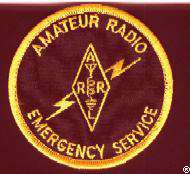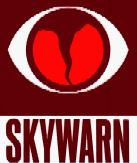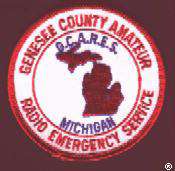Once again WD8KVD, Dr. Valerie Brady, is not only the fastest CW operator among YL's; but, with KOØU (now KØXP), has operated CW faster on the air than any other Amateur anywhere in the world, so far as can be determined. (Her first record-setting run is also recorded in QST, April 1998, p. 38).
(WD8KVD, operating HSCW at W8WN. Click on the photos of her for enlargements)

Val had not had a CW QSO since making perhaps a half-dozen while a Novice many years ago. While visiting her family W8WN and WD8KVD for Christmas in 1997, she was challenged by KOØU to attempt a High Speed CW Meteor Scatter (HSCW or HSMS) QSO at 8600 lpm (1720 wpm) And then, a year later...but that's getting ahead of the story.
Val had never been interested in CW, but had managed to pass the 13 wpm test for her General Class license nearly two decades ago. She had always been very active, but only on 2-meter FM in emergency and public service work. (There was plenty of this in Mid-Michigan with the Genesee County Amateur Radio Emergency Service, Inc., which had an average of 40 activations per year). But her copying of CW had been limited to identifying a repeater when traveling, as she simply had no interest in that mode of operation. When she visited her family in KY (EM77) for the 1997 Christmas holidays and heard the playback of saved WAVE files from some HSCW schedules, she found the mode to be interesting. Val also discovered that she could still copy the code!
 W8WN then suggested that she should take over his daily 15-minute HSCW sked with KOØU/1, FN42, and become the first YL in North America to make a HSCW QSO. She didn't think she could handle it. But after 15 minutes of playing with the HSCW program MS_DSP, she found that she not only could handle the program but could also copy short meteor-scatter-type sequences at 15-20 wpm. So she agreed to try it if KOØU was willing.
W8WN then suggested that she should take over his daily 15-minute HSCW sked with KOØU/1, FN42, and become the first YL in North America to make a HSCW QSO. She didn't think she could handle it. But after 15 minutes of playing with the HSCW program MS_DSP, she found that she not only could handle the program but could also copy short meteor-scatter-type sequences at 15-20 wpm. So she agreed to try it if KOØU was willing.
Steve, KOØU, jumped at the chance. So the next day, 1997 December 24, WD8KVD took over the morning 15-minute sked. It required 20 minutes, plus an additional 5 minutes of "73" and "TNX" for final confirmation, and the 5000 lpm (letters per minute - or 1000 wpm) HSCW contact was complete.
Val was surprised that it was so easy. No, W8WN didn't copy the code for her. She copied her own code and also handled all the transmit functions herself. W8WN did copy along, wearing a second set of headphones. It was observed, when comparing notes on what had been received on the pings, that each copied best during slightly different portions of the ping. W8WN, with more experience on CW, sometimes copied a little more. But at the beginning and end of a ping, as the signal was in the noise, WD8KVD often copied an additional letter or two. Even though W8WN thought his hearing had deteriorated very little (which would be a surprise, after 40+ years of digging for VHF DX signals), Val's younger ears were slightly better at pulling the signal out of the noise.
Then the big challenge was thrown out by KOØU - why not break, or at least tie, the world record for HSCW speed? (This was held by W8WN and KOØU, at 8500 lpm, the fastest that MS_DSP would then transmit).
Val listened to some WAVE files of 8500 lpm pings saved during that 8500 lpm W8WN/KOØU contact. Even slowed down -60x, the maximum possible using that version of MS_DSP, the playback speed was still almost 30 wpm. This is rather fast for a Ham who does not work CW! But after a few minutes, letters started coming through. "Sure," she said. "Why not!"
So on 1997 December 27 (which happened to be the birthday of Lora, WD8LPN, Val's mother), another schedule was attempted with KOØU. Steve was transmitting at 8500 lpm. In order to squeeze the last bit of speed out of MS_DSP, all spaces were removed from all sequences for transmitting by WD8KVD, making her transmit speed approximately 8600 lpm, using standard audio tone injection (J2A emission). Receiving was done by ear at both ends using MS_DSP to slow the received CW down to about 30 wpm and to then heterodyne the tone to a usable pitch. (In spite of what some people think, there are no programs available that are capable of decoding extremely short, weak make-break CW meteor scatter signals at these speeds).
Complete calls were copied by Val on the very first receive period, but it took another 10 minutes before a report was received. Once again, in about 17 minutes, the QSO was complete and "73" and "TNX VAL CUL" exchanged. The 8600/8500 lpm QSO was complete. The record for the highest known HSCW QSO speed in the world was now held by WD8KVD and KOØU - but WD8KVD was neither a CW nor a VHF DX operator! And she did not find it difficult to do.
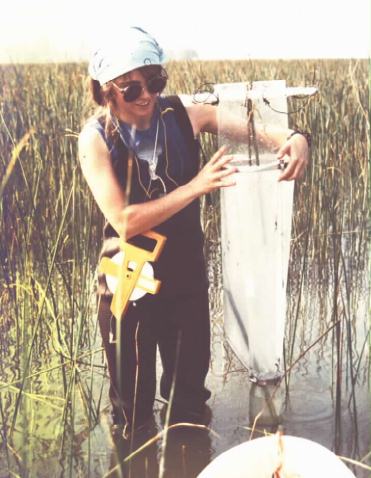 When it was pointed out that it was a surprise that she could handle all of it so easily when some male-type operators were having major problems with CW at any speed, her reply was something to the effect of "What did you expect? I'm a girl! Of course it was easy!" (These may not have been her exact words, for W8WN's ears suddenly became slightly clogged by the steam rising out of them). Dr. Valerie Brady is a wetlands ecologist specializing in entomology (i.e., she studies water bugs), a former EMT, is very computer literate, and an experienced phone operator, many times having been one of the people closest to a major fire or other type of emergency.
When it was pointed out that it was a surprise that she could handle all of it so easily when some male-type operators were having major problems with CW at any speed, her reply was something to the effect of "What did you expect? I'm a girl! Of course it was easy!" (These may not have been her exact words, for W8WN's ears suddenly became slightly clogged by the steam rising out of them). Dr. Valerie Brady is a wetlands ecologist specializing in entomology (i.e., she studies water bugs), a former EMT, is very computer literate, and an experienced phone operator, many times having been one of the people closest to a major fire or other type of emergency.
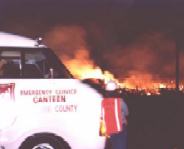 She has gone into still-burning buildings with the County Fire Coordinators, had missiles from a burning gasoline tanker whiz past her head, and had to hit the ditch as a tornado appeared to be forming directly in front of her. (Such were her experiences with the GCARES). But this was a completely new challenge, especially for a YL.
She has gone into still-burning buildings with the County Fire Coordinators, had missiles from a burning gasoline tanker whiz past her head, and had to hit the ditch as a tornado appeared to be forming directly in front of her. (Such were her experiences with the GCARES). But this was a completely new challenge, especially for a YL.
Soon after this record was set, 9A4GL released another Beta version of his HSCW program, MS_DSP, V. 0.70. This version was capable of transmitting as fast as 16,500 lpm (3300 wpm). It wasn't long before W8WN and KOØU had completed a contact at that speed to see if it could be done. It was possible, although difficult. Subsequent testing showed that the signal-to-noise ratio dropped off rapidly above 10,000 lpm (2000 wpm). So the daily MS schedules between W8WN and KOØU continued at speeds of 12,000 lpm or slower.
Then came the Christmas holidays of 1998, and Val again left frozen Minnesota for Kentucky. Once again KOØU threw out the challenge for Val to again become the "fastest CW operator on earth". You can no doubt guess the rest. For transmitting, MS_DSP's speed was set at the new maximum of 16,500 lpm, and all spaces were removed (European style) to make the actual transmit speed approximately 16,600 lpm (3320 wpm). KOØU transmitted at 16,500 lpm. Meteor scatter signals from the kilowatt rig of W8WN/WD8KVD were very good at KOØU's end. But Steve's lower-power signals were quite a bit weaker; and with the considerable loss of S/N ratio at this speed, copy was difficult when the pings were slowed down to about 30 wpm. An audio filter was required to help pull the slowed-down signals out of the noise and ringing (ringing is an artifact of the DSP speed-reduction process). Once again, the younger ears of WD8KVD copied slightly more than the noise-battered ears of W8WN.
This schedule required half an hour to complete, due to the above-mentioned difficulties. But after 33 minutes, the high voltage power supply to the final was shut down and the completed contact was logged. WD8KVD and KOØU had once again completed a meteor scatter contact at the maximum possible speed.
To set things straight, all of those involved see nothing special about running at that speed for a "record." Using high-speed CW and MS_DSP, meteor scatter at the "normal" speeds of 2000-8000 lpm is relatively easy. It was done just because it was a challenge and Val was interested in trying it. The actual speeds really aren't important. What matters is how easily she was able to handle it. MS_DSP, a shareware program written by Tihomir Heidleberg, 9A4GL, is usable to about 10,000 lpm (2000 wpm) with little reduction in signal-to-noise ratio. But at higher speeds, it loses its efficiency. Speeds above 10,000 lpm are not recommended for routine schedules. (For a comparison, the German "DTR" dedicated HSCW solid-state digital "recorder", works well up to 8000 lpm, while a modified cassette tape recorder is usable to 2000 lpm [or perhaps as fast as 4000 lpm by using heterodyning techniques to increase the tone frequency of the received signal]). For more information on High Speed CW Meteor Scatter operation, visit the W6/PAØZN main North America HSCW Web site at URL W6/PAØZN main North America HSCW Web site.
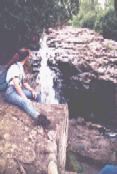 Don't bother requesting a sked from WD8KVD, now that she's back at her QTH in MN. All she has up there are several walkie-talkies and a mobile FM-only rig (which had some problems during the -35° F (-37° C) temperatures experienced while providing communications for the John Beargrease Dogsled Marathon later that winter).
Don't bother requesting a sked from WD8KVD, now that she's back at her QTH in MN. All she has up there are several walkie-talkies and a mobile FM-only rig (which had some problems during the -35° F (-37° C) temperatures experienced while providing communications for the John Beargrease Dogsled Marathon later that winter).
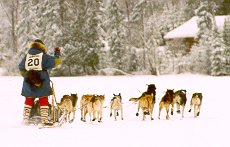 But maybe, if she comes back down to KY next Christmas, you can talk her into a HSCW sked at that time. But that's up to her. I sure can't tell her what she should do any more!
But maybe, if she comes back down to KY next Christmas, you can talk her into a HSCW sked at that time. But that's up to her. I sure can't tell her what she should do any more!
In July 1999 W8WN and WD8KVD attempted low-power HSCW operation from her QTH near Duluth, EN46ax. Click here to read this story.
